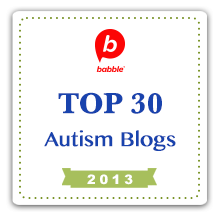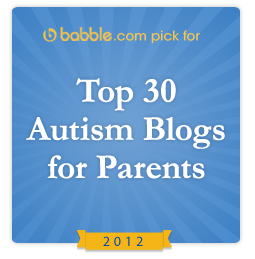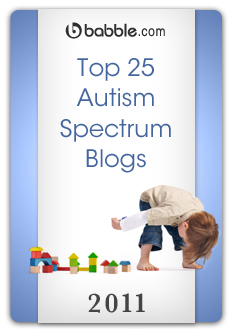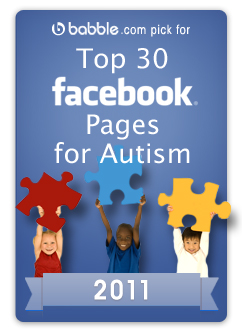Allow me to explain, in plain English, what autism is. If you have any interest in learning about autism at all, please give this a read. I’ll even keep it short (well, compared to a textbook anyway).
Technically Speaking
To start at the top, there is PDD (Pervasive Development Disorder) which is a group of disorders including Rett’s, Childhood Disintegrative Disorder and ASD (Autism Spectrum Disorder).
Within the Autism Spectrum Disorder, there is actually another group of disorders including:
- Autistic Disorder (also called “classic” autism)
- Asperger’s Syndrome
- PDD-NOS (Pervasive Developmental Disorder Not Otherwise Specified or “atypical” autism)
So being “on the spectrum” and “having autism” may not mean exactly the same thing although some people, even professionals, may use them interchangeably.
I should also mention, Fragile-X is a genetic syndrome that is not autism but may cause autism.
Something I need for you to know
First and foremost, you need to understand that every single person that is on the autism spectrum is different. That means that every single symptom and situation is different.
From here on out, everything I tell you may affect a lot of autistics but not all.
Common Symptoms
- Communication Impairment
This can be broken down into a few areas, such as:
– Literal Thinking. This happens when a person is unable to, or has great difficulty, in understanding such things as irony, sarcasm, metaphors, expressions, etc. To use a phrase such as “I laughed my head off” would be interpreted by an autistic literally, they picture that your head actually came off.
– Inability to Understand Non-Verbal Queues. Many autistics explain that they are unable to tell what others are thinking by reading facial expressions or body language. Recognizing a person’s emotions is very difficult unless stated specifically and literally.
– Anxiety. Extreme fear of social situations often makes socializing near impossible. Autistics often prefer to avoid social gatherings despite having a strong desire to be a part of them. Autistics often feel like foreigners, speaking another language, in a place where they do not belong.
- Sensory Processing Disorder
Despite being a separate disorder, SPD (Sensory Processing Disorder) is quite common among those with autism. This is broken down as such:
– Hypersensitive. Autistics often have an aversion to loud noises, lots of noises, bright lights, flickering lights, scratchy clothing (such as wool, seams), strong tastes, food textures and more. Anything that can overload the senses. Sometimes a simple hug can feel very painful all over.
– Hyposensitive. Often times, people with autism have a high tolerance for pain, sometimes not even realizing that they’ve been hurt. The same is sometimes true of all of the five senses. While a person may hate being touched at times, sometimes they have an overwhelming need to be touched. Often weighted vests, blankets, etc can help.
– Filter. While not a sensitivity, often the brain lacks the filter that most people have to remove background sounds, smells, sights, etc. For example, when you go into a restaurant, the music, kitchen sounds and other people talking all fade to the background so that you can hear the people you are talking to. With an autistic person, this is sometimes impossible… they hear it all at the same time, at the same level and become overwhelmed.
- Routine / Repetition / Patterns
An early warning sign is a child’s need to follow a strict routine, make repetitive sounds or actions to excess or to create patterns out of objects rather than play with them.
– Routine. All children need routine but children with autism especially need it. A break in routine can leave a child feeling completely lost, out of control and overwhelmed with anxiety. The severity of this varies greatly.
– Repetition. Children with autism often repeat words, sounds or actions over and over again for much longer than what you would call a phase. These are usually single words, small sounds or small actions… repeated over and over again.
– Patterns. Often children will line up cars in a straight line, put their cereal into grids or lines, single out single elements from a more complex pattern or anything else along similar lines. Rather than actually playing with objects, they’ll find more joy in aligning them somehow.
- Stimming (Self Stimulating)
Stimming can be defined as a person’s need to produce an output, a way to fill one, more than one or all of a person’s senses (input).
– What is it? Stimming comes in many forms but some notable occurrences include arm or hand flapping, moaning, head shaking, spinning, hitting oneself, moving one’s hands in front of their own eyes and so on.
– Why do it? Stimming is done either to satisfy a need for input, such as a craving for deep pressure or to hear something, or as a way to block out other input, such as moaning so they no longer hear all of the other noises in a room (fan, television, people, etc) or to feel deep pressure so that they no longer feel the scratchy fabric of their clothing. These are just examples of an infinite number of possibilities.
– Stop it? Some people wish to stop their child from stimming which, depending on the circumstances, can be beneficial or harmful. If stimming is done for self satisfaction and interferes with their ability to perform needed tasks, stopping it may prove beneficial. However, if the person is stimming to block out other overwhelming stimuli, preventing them from doing so may lead to a meltdown.
- Meltdown
So what is a meltdown exactly? Is it just a temper tantrum? Can a child be disciplined out of it?
– Temper Tantrum. A means to get ones way, or to express extreme dissatisfaction with being unable to get ones way.
– Meltdown. A complete loss of control over one’s faculties due to overwhelming anxiety, fear, pain, sensory overload or other outside pressures. A meltdown is very much akin to a reaction one may have to being tortured.
Epilepsy/Seizures
Approximately 20% to 35% of individuals with autism have a seizure disorder. About one in four autistic individuals begin to have seizures during puberty. The exact reason for the onset of seizures is not known, but it is likely that the seizure activity may be due to hormonal changes in the body.
Sometimes seizures are noticeable but most of the time, they happen so subtly that it can not be detected by simple observation.
Wandering/Elopement
In 2008, Danish researchers found that the mortality rate among the autism population is twice as high as the general population. Often times, a parent reports looking away for only a brief moment to find that their child has wandered off. Often times, they are found in neighbor’s pools, nearby woods, on highways and more.
People with autism seldom recognize the fear or danger in wandering off from the comfort of their surroundings.
Severe vs Savant
As a spectrum, autism can range from one extreme to another where one person may not be able to speak, use a toilet or dress themselves to another person that can remember Pi to over 25,000 places.
In the past, a person was considered “severely autistic” if non-verbal but today we now know that a person can actually have a normal or even high IQ despite verbal or other impairments. This means that just because a person can not speak, use a toilet or dress themselves, that there isn’t a very smart individual in there wishing to express themselves.
Also, not all savants are autistic even though “autistic savant” is when we hear the term most.
While autism can be a life long, debilitating disability for some, and while it may provide savant, superhuman like gifts to others, the fact is that for the most part, autism is a disorder which leaves people somewhere in the middle. Unable to handle a regular classroom, social setting, conversation and more but able to live independently with proper treatment and therapy.
Why an autistic person might not look me in the eye
One common recognizable sign or symptom of autism is the person’s inability or desire to look at a person’s face, or look them in the eye. Several well known autistics have described the process as “taking thousands of pictures of a person’s face every time I look at them”.
This is understandably very overwhelming and so, to avoid being overloaded into a meltdown, sometimes they will refuse to look you in the eye.
Other times, it can be described as simply a social awkwardness where they feel too much anxiety or discomfort with doing so.
Also, as with everything, this is not true of all people with autism. You’ll find that a good number of autistics really have no problem looking at you.
Causes
Other than Fragile-X causing some cases of autism, no one knows the cause for the rest. Genetics and other environmental factors (which includes vaccines) are often discussed in the media but no matter what you’ve read, no one knows the cause with 100% certainty.
Treatments / Therapies / Diets
There are countless treatments available although ABA (Applied Behavior Analysis) is the most widely used and approved method.
The most common therapies that help children are speech therapy and occupational therapy.
Diets proven to have the most positive effects include the GF (gluten or wheat protein free) and CF (casein milk protein free) diets.
No one treatment, therapy or diet will work for all people with autism although most have met with some success with at least some people. Because of this uncertainty, there have been some people who take advantage of the situation and create “snake oil” remedies which cost a lot of money yet don’t really work.
The truth is, though, that because no one knows the cause, no one knows the cure. As of right now, autism is a life long disorder with no cure.
Everyone agrees that the best chance an autistic person has at an independent life is via early intervention, which means receiving a diagnosis between the ages of 2 to 3 followed by receiving therapy, treatment and other help as soon as possible while still in the early development stage of their life.
How can you help?
- Be understanding. Reading this is a great first step. The simple fact that you have taken a moment to know some of the characteristics and symptoms means a lot to a person with autism or their parent. Now that you know what stimming is and why it probably should not be stopped sometimes goes a long way toward understanding the person that is doing the stimming.
- Do not judge. When you see a parent with a child that is screaming on the floor at a restaurant or grocery store, don’t be so quick to think that they’re a bad parent or a bad child. Perhaps that child is autistic and having a meltdown due to outside stimuli which feels like a constant stream of pain… such as torture. If you felt what that child has just been feeling, you may react in the same way. Autism can NOT be disciplined out of a person. It is hardwired in their brains.
- Be accepting. If you know a child with autism, accept them for being different and needing to stim or be alone sometimes. If you’re at a party and you see someone on their own, be kind but respectful if they request to be left out of the group. If you employ someone with autism, give them a little extra room to cope with the crazy atmosphere around them and don’t be too hard on them if they avoid the X-Mas party. There are many ways you can adjust your own expectations to be accepting of their differences without having to necessarily give them special treatment.
So Remember
All people with autism are different. No one symptom is common among 100% of people with autism. No one therapy, treatment or diet works. Not all autistics are brilliant, not all autistics are non-verbal and not all autistics are dependent nor independent.
Chances are, you know someone on the spectrum and not even realize it. They may not even realize it either.
Please print this or copy it and share it with anyone wishing or willing to know more about autism.
Thank you.
 We went to the Friday evening show of The Dinosaur Petting Zoo at the Tilles Center last week. We had to get their early to pick up our tickets for the general admission show; showing up at 4pm for a 5pm show. When other families started arriving, my wife’s first comment was “uh oh, it’s a little kid’s show”. Indeed, the overwhelming majority of children showing up for this puppet show were under 8 years old. Mike, our youngest of three and bona fide paleontologist-in-training, is 12 years old.
We went to the Friday evening show of The Dinosaur Petting Zoo at the Tilles Center last week. We had to get their early to pick up our tickets for the general admission show; showing up at 4pm for a 5pm show. When other families started arriving, my wife’s first comment was “uh oh, it’s a little kid’s show”. Indeed, the overwhelming majority of children showing up for this puppet show were under 8 years old. Mike, our youngest of three and bona fide paleontologist-in-training, is 12 years old.











